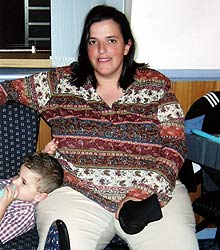The Low-Carb Roundtable, Part II
Featuring Charles Poliquin, Cassandra Forsythe,
Dan John, Dave Barr, and Joel Marion
Moderated by Greg McGlone
Note: Miss Part I? You can find it
HERE.
T-Nation: Okay, you guys gave us a lot to think about in Part I. Next topic: For competitive athletes, how do you feel about a long term low-carb approach?
Charles Poliquin: If you're talking about energy system sports like kayak or speed skating, then I'd say that low-carb diets don't do well for these because of the demands on their glycogen stores, but those athletes tend to be insulin sensitive anyway.
Though an extremely low-carb diet would probably not be the perfect way to go for Olympic quality athletes, it's interesting that the one study that was done with high performance athletes and a ketogenic diet (a very extreme form of low-carb diet) showed that their performance returned to "normal" (which for them was world class) within a month of being on the diet, showing that adaptation takes place.
 T-Nation
T-Nation: Interesting. What's your take, Dave?
Dave Barr: Again, psychology plays a big role here. If you had asked me this question several months ago, I would've suggested that elite athletes need to maintain moderate carb diets for most of their training time — that is, until I began to see the results that John Berardi has been getting with his clients. Hard to argue with results like that.
For people who are less "hardcore," it's not realistic to stick them on a low-carb diet. To be honest, if someone isn't going to make a living at their sport, it's best that they live life and enjoy a wide range of healthy food.
T-Nation: What say you, Miss Forsythe?
Cassandra Forsythe: No matter what diet an athlete follows, they have to eat enough energy to prevent their performance from suffering. A long-term LCD approach doesn't stop you from being a competitive athlete.
Many sports nutritionists tell us that in order to be successful in sports, we have to top off muscle glycogen stores by eating loads of carb foods. However, when you limit carbs, you use intramuscular triglyceride and stored body fat for energy. Once this transition has occurred, athletic performance (even competitive athletic performance) is sustained.
We just need to educate our athletes about the foods they can easily eat when following a lower-carb diet so that energy imbalances are avoided. Some believe that if an athlete follows a strict VLCKD, they also need extra electrolyte support (because of increase sodium and potassium losses in the first weeks of the diet change) and should give careful attention to fatty acid composition (ensure enough omega 3's to reduce inflammation).
For athletes that can get away with eating slightly more carbs due to their high activity levels, they don't need to be so careful, but should ensure that the carbs they eat don't reduce their ability to use fat as a fuel. They can eat some "smart carbs" like sweet potatoes, extra fruit, and oatmeal, but they must keep fat and protein high. It's not necessary for them to consume 65% of their calories from carbs because they get more energy from the increased protein and extra fats.
Overall, as long as they eat enough calories, any competitive athlete can perform just as well eating less calories from carbs and more calories from protein and fat as they would eating a high-carb diet.
T-Nation: Bold statements! Let's let Joel chime in.
Joel Marion: What would be the purpose of having athletes on a long-term low-carb diet? If you'd like to keep them lean, then there are certainly other, more enjoyable ways to achieve that goal, without the negative effects that a very low-carb approach will have on muscular strength and hypertrophy and overall performance.
Carbs can still be consumed while maintaining low levels of body fat. The solution is timing them appropriately around exercise and other times of day in which insulin sensitivity is highest, not cutting them out completely.
T-Nation: What do you think, Danny?
Dan John: For my athletes, I think that diet is a long-term health issue. I'm not sure that a thrower or lifter really needs to worry about how diet will impact performance. Really, I've thrown far after having the flu and vomiting for a couple of days. I've also performed awful with perfect conditions.
You could carb up and get to 70% body fat and still probably throw stuff far, but you'll have to account for that later in life. I've heard, though, that the great Kenyan distance guys eat a lot of meat and veggies and never drink those little carb drinks you see on TV that make your sweat change color.
So, low-carb dieting will keep a handle on body fat and may help with food allergies. Not everyone agrees with the food allergy thing, but I don't know of an experienced athlete or coach who won't agree that this problem exists...at some level. It could be as bad as fatal (truly something that would hurt performance and you can quote me on this: "Dan John thinks death hurts performance!") to simply subtle like you find with distance runners who worry a lot about bowel movements on race days.
Performance is an "iffy" thing. If low-carbing eliminates an "if," then I'd be crazy not to recommend it. It won't make you a gold medalist by itself, but it needs consideration.
T-Nation: Okay, I'd like to hear all of your opinions on post-workout (PWO) nutrition. Charles, I know that you've advocated the use of glutamine among other things in PWO period, while Dave has spoken out against glutamine. There's also the debate about ketosis, which as Joel pointed out, may not be necessary at all to make progress. What are your thoughts on PWO nutrition for someone utilizing a low-carb approach?
Dave Barr: I never really understood the whole glycogen repletion with glutamine theory, so I'm looking forward to hearing the other contributors' answers.
For the moment, let's ignore the possibility that glutamine does nothing to enhance glycogen storage, and simply assume that it occurs. Now, wouldn't this newly stored glycogen be used for energy at the expense of fat? Of course it would. So what's the concern here? Stimulating insulin?
Well then, that raises the question of whether 40-80g of glutamine, along with your 40g of fast protein and amino acids, will elevate insulin. This isn't an unreasonable question because glutamine acts like glucose in so many respects. While glutamine isn't known as a powerful insulin secretagogue, the doses in question make this a whole new ball game.
Even if insulin isn't secreted by the protein and mega-dose of glutamine, how would this compare to carbohydrate-induced glycogen repletion? Well, the insulin released due to the PWO carbs and protein would enhance protein synthesis and muscle recovery. This is not so with the glutamine.
Would the insulin shut off fat loss? I don't think it would, compared to glutamine, especially considering that you're PWO and you're already on a low-carb diet. At this time, our body isn't concerned with storing fat, only recovering. Again, we're already assuming that we're storing glycogen with glutamine (for the sake of argument) which is an energy source to be used instead of body fat.
So even if we give glutamine the benefit of the doubt with every question, and that's giving a lot, there's no advantage I can see from glutamine use in a low-carb situation.
Charles Poliquin: Again, insulin management is the key. Glycogen stores are an issue. The right mixture of whey isolates, glutamine, and glycine does wonders for recovery while improving body composition. I've made many hockey players go from 20% to 8% in eight weeks using that post-workout formula. How research applies to the real world is another debate, but practical experience is what counts.
I know that David "Candy" Barr doesn't believe in it, but strength coaches tend to be eight years ahead of exercise physiologists, who are in fact exercise historians. David is a strong believer in economics through volume, hence he sports a keg instead of six pack!
Ketosis is overrated and not necessary for making progress. I agree with Joel on that matter.
Cassandra Forsythe: PWO nutrition doesn't have to be about eating oodles of simple carbs just to quickly replenish glycogen. Most weightlifters don't even deplete glycogen, so why worry about trying to maximize this response by causing horrendous spikes in glucose and insulin?
When you follow a low-carb approach, your body is using both fat and carbohydrate as a fuel, so there's even less glycogen depletion. Thus, ingesting a lot of high-glycemic simple carbs in the PWO period isn't as crucial. It's necessary though to eat something soon after your workout, but the foods chosen will depend on your level of carb restriction.
If you're following a high-calorie LCD you can eat your choice of "smart carbs" in combination with some high quality protein (like oatmeal, fruit, and whey protein). Given that you've increased your insulin and glucose sensitivity by following a low-carb approach, you don't need to consume something like dextrose-maltodextrin to get a good insulin response.
If you're following a VLCKD, you may just want to stick with a high-protein and fat meal so that you avoid knocking yourself out of ketosis. It all depends on your goals and how sensitive you are to carbohydrates. Some people don't feel that a high-carb drink after their workout gives them any benefits. These people do better eating some smaller quantity of carbs in conjunction with a high quality protein source.
The most important issue is to just make sure you eat something within a half hour of your workout, and consume enough energy throughout the day so your next training session isn't ruined.
Dan John: It depends on what day or what year it is for me to tell you my beliefs in post-workout nutrition, because it changes all the time. Every time I go to a workshop, I have a new opinion. With my athletes, dinner is often PWO, so they eat a variety of things, often from a place with a red and gold clown as nutritional advisor.
I know it's the key to a lot of "this." But, outside of a camp situation, we just make do with what we can do. Listen, I'm still trying to get my athletes to eat breakfast, for God's sake!
T-Nation: Dan always keeps us practical! What's your take, Joel?
Joel Marion: Carbs should never be omitted around a resistance training session. There's just no good reason for it. If the reason is worry with regards to fat storage, that's a non-issue with properly timed carb intake during/post exercise.
As David and I have stated, the body isn't concerned with storing fat at this time, only recovery. If the issue is remaining in ketosis, again, not a very good reason, as actually being in ketosis has very little to do with fat loss and progress.
Basically, as I've been saying, there are no drawbacks to carbohydrate consumption at this highly sensitive time, only benefits to be had. So my PWO recommendations to someone utilizing low-carb approach: drop the low-carb approach and get on the nutrient timing wagon!
But what if you couldn't consume carbs, what would the next best thing be? From the research, it's an EAA drink, but as I've mentioned before, I hate hypothetical, unrealistic questions like this. You have the option to consume carbs and there's no reason not to do so.
T-Nation: Okay, some of you prefer a cyclical approach when it comes to carbs. I'd like to hear all of your thoughts on any aspect of cycling carb intake.
Charles Poliquin: Compliance and results dictate how well you'll do in the strength coaching business. I've learned a lot from Mauro DiPasquale about how to cycle carbs. In a nutshell, for most (but not all) individuals, I like this approach:
First phase (initiation): 14 days low-carb, one day off completely
Second phase: As needed to reach goal
I have the client use a 4:1 ratio for as long as needed. That is, four days low-carb, one day off. "Off" is a broad term. The leaner you are, the more you can eat carbs. At 6% you can go crazy.
Every fifth day you should go back to eating more good carbs, as oxidation of branch-chain amino acids is compromised on low-carb diets. The amount of good carbs is inversely proportional to your percentage of body fat.
If they're fat, the client only has the single cheat meal, at dinner, where he or she can eat as many carbs as they want — once they've eaten their protein. If their ass leaves the table, the carb intake is done for the day.
Carbs at dinner doesn't mean that cookies and donuts can be eaten in front of the television all night long. It's important that the cheat meal is at the dinner table; people can eat far more carbs for a longer time in front of the TV. You may start to add a second cheat meal once you hit 8% body fat.
Cassandra Forsythe: Most people probably will agree that if you want to eat certain carb foods, the best time to eat them would be in the hours after your workout. This thought comes from the fact that any increase in insulin elicited from the high-carb meal will be used to shove glucose into those previously worked muscles, rather than converting it to fat and sending it to adipose for storage.
In terms of cyclical approaches, I don't think that's the best way to follow a LCD. If you want to gain the best results from a low-carb approach, just be consistent and keep your carb intake controlled.
Dave Barr: Have I mentioned psychology yet? Using a Metabolic Diet with five days of low carbs and two days of higher carbs is more user friendly than similar diets with different parameters. The Metabolic Diet books go into detail about why the five on, two off system works well physiologically, but for the sake of simplicity, it's great for maintaining muscle and continuing fat loss, all in a nice neat package.
"Low-carb during the week, more-carb on weekends" is relatively easy to follow, because so many people naturally function on a weekday vs. weekend schedule. This also enables you to enjoy your weekend, each and every one, without too much concern that you've blown your diet. Ease of use is the number one determinant of compliance, and coupled with the fact that it works physiologically, the Metabolic Diet is win-win.
Dan John: I had great success on the "five day zero-carbs, two day carb-up plans" — CKD, Anabolic Diet, and the variations. I found that I quickly shrunk it to a 36 hour carb up because I felt awful. I stay fairly low-carb all the time and I have personal issues I think with the grain family, so I feel better just ignoring them completely.
The upside of cycling carbs is that you can eat this or that. The downside is that, well, if you take a little poison, it's still poison. So, this is one of the great "YMMV" of the Atkins forums: Your Mileage May Vary. For me, I do best on meat, veggies, and fruit with a lot of water and fun in my training. When I ignore that advice, bad things happen over time. Which brings us back to "Why do I ignore this advice?"
Joel Marion: I've used, with great success, a couple forms of cyclical carb type diets with clients. One form that I like to use for clients looking to "body comp" or achieve simultaneous fat loss and gains in muscle mass, is an alternating approach between moderate/lower carb days and higher carb days depending on activity.
For example, clients are consuming carbs, and plenty of them, on training days both during and following intense weight training. On non-weight training days, carbs are consumed only in the beginning part of the day and are limited to low GI sources. Carb intake is substantially lower on these days, falling in the "lower carb" category. The amount of carbs that are allowed on each day is dependant on the client's level of body fat.
The leaner the individual, the more carbs they're generally allowed. If the goal is simply maintenance of body fat, more carbs are allowed (this obviously translates into potentially greater gains in lean body mass, although the trade-off is lessened fat loss).
I'll also cycle in a couple of very low-carb days into a fat loss diet every so often after a day of overfeeding to help alleviate any water retention resulting from the previous day's high carbs and calories and quicken progress thereafter. Because leptin levels and other metabolic markers are elevated right after an overfeed, we can get away with a strict low-carb approach during this time.
By using that dietary approach in conjunction with heightened activity (two or three cardio sessions the first day, one or two the next day), it's possible to lose a substantial amount of fat in the two-day period following the metabolic priming of an overfeed.
Make no mistake, I'm still no fan of very low-carb dieting for anything even remotely long term, but I do believe it can be effectively used in extremely short bursts.
T-Nation: Wow, lots of things to think about here! Any closing thoughts?
Dave Barr: Although we've focused a lot on this particular diet, I prefer the idea of just eating a wide variety of healthy food, without any severe restrictions. Of course that's not sexy and won't sell, but food is one of the greatest pleasures in life, and is meant to be enjoyed.
For those who want to use a low-carb diet, I suggest checking out Dr. DiPasquale's Metabolic Diet and The Anabolic Indexby yours truly, which will feature information on how best to increase muscle mass and subsequently lose fat while on both calorie- and carb-restricted diets.
Charles Poliquin: A lot of people are kidding themselves about how many carbs they need. "Man, I need my carbs." Yeah, right! What you need to realize is that there's a difference between a mouth and a vacuum.
It should be more "low-carb lifestyle" than "low-carb diet." Forty to fifty grams per day of good carbs is plenty for most of the population. That is why there are so many fat dieticians and personal trainers. I recently saw a former author of this site at a nutrition conference. He's a legend in his own mind for his dietary counseling prowess and a record holder of never healing weight training injuries.
Look at him, and his physique will you tell that he has never met a carb he didn't like! In my usual diplomatic style, I put an end to his endless diatribe by asking Porky Pig the following three questions:
1) "Enlightened grand master, if you're such a fine nutritionist, how come you have more chins than Chinatown and that you get harpooned when you go swimming?"
2) "Have you ever considered that the number of never healing injuries you brag about are caused by the inflammatory response subsequent to your enormous carb intake?"
3) "If you're never going to stop eating Doritos, could you please call TC and me the night before so we can shore up the supply?"

In fact, the only way this pestering motor mouth will ever get lean is to limit his carb intake to ten licks of a dried prune... spread throughout the day.
One needs to distinguish the difference between carbs and "neo-carbs." Neo-carbs were not accessible to cavemen. Did a caveman have access to donuts? No. Donuts are neo- carbs. Did a caveman have access to pasta? No. Did a caveman have access to raspberries? Yes, raspberries are allowable carbs, except in the initiation phase.
Nutrient timing makes a difference, too. I think a lean 200-pound man can keep his leanness eating 250 grams of carbs a day, if 200 of them are taken post-workout and the other 50 grams spread throughout the day in low glycemic carbs. Remember, I said "stay lean," not getlean. Get lean first if you want to eat carbs. The leaner you are, the more carbs you can eat.
Some more closing thoughts? Here you go:
No one eats enough vegetables. Have you ever heard on anybody having a binge on brussel sprouts?
I don't believe in counting calories. It's a waste of time.
You can dramatically improve insulin sensitivity. Recently, in Toronto, I gave 16 hours of info on that topic alone. There are plenty of nutraceuticals (i.e. R-form stabilized alpha-lipoic acid, not the useless racemic form that everybody sells), and botanicals that will improve insulin sensitivity, and there are functional tests that can determine which ones would work best for you. Insulin sensitivity and the ability to hypertrophy while leaning out are strongly correlated, more so than androgen output.
Finally, low-carb fats without a high intake of smart fats is suicidal. That's probably why many people fail to have results on low-carb programs.
Cassandra Forsythe: The low-carb craze is definitely not dead. In fact, it's not even a craze, but rather a lifestyle modification. We've been fed lies about fat and protein too long. Fat doesn't make you fat, nor increase your risk for heart disease, cancer, or diabetes. Along the same lines, protein doesn't damage our kidneys or contribute to chronic disease.
By now you've probably all heard about the results from the recent Women's Health Initiative, and if you haven't, you should really take a look at the data. Basically, low-fat diets failed to provide any of the health benefits that researchers have told us they would for the past 20 or 30 years.
Researchers were backed into a corner when they tried to explain those results. They said "Oops! We lied and actually had no evidence that a low-fat diet was good, but we told everyone to follow it anyhow. Sorry about that." This gives us even more reason to consider the alternative.
There's an abundance of good science backing up the beneficial application of low-carb approaches for prevention of several metabolic disorders and as a positive lifestyle improvement. We have to stop pretending that low-carb is just a fad.
Dan John: Obviously, I'm still sifting through some of this stuff myself and I'd image others are, too. It's the great paradigm shift of many of our lives. For years, we thought jogging and eating pancakes dripping in syrup while stretching every joint to the brink of snapping was smart training. Well, "we" didn't...
So, now the great glacier of thought in training is turning another direction and we really need to break out of a worldview that was not only wrong but hurtful. So, here we go.
Joel Marion: With regards to carbs and nutrition, it's all about the two T's: timing and type. Yes, Americans are fat because they consume far too many highly processed carbohydrates, but heavy carb restriction is just an oversimplified way of dealing with the issue, and unfortunately the oversimplification carries along with it a lot of drawbacks.
The answer isn't eliminating the macronutrient; it's learning how to make better carb choices and how to time carb intake appropriately during times of the day in which they'll be well accepted. When this is done, there's absolutely no good reason to heavily restrict carbohydrate consumption. Their ingestion during a diet phase is associated with many benefits, both physiological and psychological.
That said, like most other things touted as the be all/end all (kettlebells, Swiss balls, low-fat dieting, etc.), its use on a much smaller scale can have benefit.




































